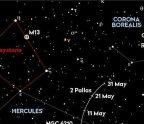
What capabilities will the Giant Magellan Telescope offer astronomers?
The Giant Magellan Telescope – due to see first light in 2031 – will be optimal for looking at light from Earth-like planets. It will be able to decompose this light and detect whether there are molecular signs of life as we know it, from diatomic oxygen to methane to ozone to carbon dioxide. Astronomers are alsobecause it means that we can detect small signals, looking far back into how the cosmos formed: how the lights turned on, how ionisation started, how galaxies were formed.






